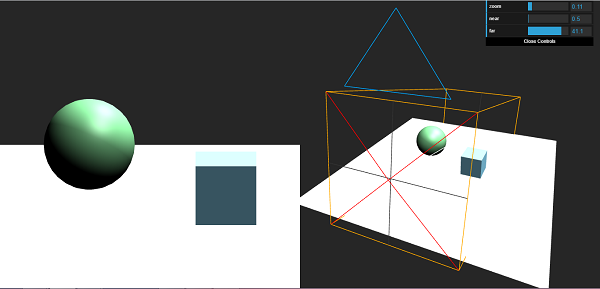
- Three.js - Home
- Three.js - Introduction
- Three.js - Installation
- Three.js - Hello Cube App
- Three.js - Renderer and Responsiveness
- Three.js - Responsive Design
- Three.js - Debug and Stats
- Three.js - Cameras
- Three.js - Controls
- Three.js - Lights & Shadows
- Three.js - Geometries
- Three.js - Materials
- Three.js - Textures
- Three.js - Drawing Lines
- Three.js - Animations
- Three.js - Creating Text
- Three.js - Loading 3D Models
- Three.js - Libraries and Plugins
- Three.js Useful Resources
- Three.js - Quick Guide
- Three.js - Useful Resources
- Three.js - Discussion
Three.js - OrthographicCamera
The 2nd most common camera is the OrthographicCamera. It specifies a box with the settings left, right top, bottom, near, and far. It represents three-dimensional objects in two dimensions.
const camera = new THREE.OrthographicCamera(left, right, top, bottom, near, far)
All the six attributes are the borders of the box; The camera renders only the objects inside the box.
left - Camera left the plane.
right - Camera right plane.
top - Camera top plane.
bottom - Camera bottom plane
near - Camera near plane.
far - Camera far plane

Example
Check out the following example −
orthographic-cam.html
<!DOCTYPE html>
<html lang="en">
<head>
<meta charset="UTF-8" />
<meta http-equiv="X-UA-Compatible" content="ie=edge" />
<meta name="viewport" content="width=device-width, initial-scale=1.0" />
<title>Three.js - Orthographic camera</title>
<style>
html,
body {
margin: 0;
height: 100%;
}
#threejs-container {
width: 100%;
height: 100%;
display: block;
}
.split {
position: absolute;
left: 0;
top: 0;
width: 100%;
height: 100%;
display: flex;
}
.split > div {
width: 100%;
height: 100%;
}
</style>
<script src="https://cdnjs.cloudflare.com/ajax/libs/three.js/r128/three.min.js"></script>
<script src="https://cdnjs.cloudflare.com/ajax/libs/dat-gui/0.7.7/dat.gui.js"></script>
</head>
<body>
<canvas id="threejs-container"></canvas>
<div class="split">
<div id="view1" tabindex="1"></div>
<div id="view2" tabindex="2"></div>
</div>
<script type="module">
// Three.js - Cameras - Orthographic 2 views
// from https://threejsfundamentals.org/threejs/threejs-camerasorthographic-2-scenes.html
import { OrbitControls } from "https://threejs.org/examples/jsm/contro
ls/OrbitControls.js"
function main() {
const canvas = document.querySelector('#threejs-container')
const view1Elem = document.querySelector('#view1')
const view2Elem = document.querySelector('#view2')
const renderer = new THREE.WebGLRenderer({ canvas, antialias: true })
const size = 1
const near = 5
const far = 50
const camera = new THREE.OrthographicCamera(-size, size, size, -
size, near, far)
camera.zoom = 0.2
camera.position.set(0, 10, 20)
const cameraHelper = new THREE.CameraHelper(camera)
class MinMaxGUIHelper {
constructor(obj, minProp, maxProp, minDif) {
this.obj = obj
this.minProp = minProp
this.maxProp = maxProp
this.minDif = minDif
}
get min() {
return this.obj[this.minProp]
}
set min(v) {
this.obj[this.minProp] = v
this.obj[this.maxProp] = Math.max(this.obj[this.maxProp], v + th
is.minDif)
}
get max() {
return this.obj[this.maxProp]
}
set max(v) {
this.obj[this.maxProp] = v
this.min = this.min // this will call the min setter
}
}
const gui = new dat.GUI()
gui.add(camera, 'zoom', 0.01, 1, 0.01).listen()
const minMaxGUIHelper = new MinMaxGUIHelper(camera, 'near', 'far', 0.1)
gui.add(minMaxGUIHelper, 'min', 0.1, 50, 0.1).name('near')
gui.add(minMaxGUIHelper, 'max', 0.1, 50, 0.1).name('far')
const controls = new OrbitControls(camera, view1Elem)
controls.target.set(0, 5, 0)
controls.update()
const camera2 = new THREE.PerspectiveCamera(
60, // fov
2, // aspect
0.1, // near
500 // far
)
camera2.position.set(16, 28, 40)
camera2.lookAt(0, 5, 0)
const controls2 = new OrbitControls(camera2, view2Elem)
controls2.target.set(0, 5, 0)
controls2.update()
const scene = new THREE.Scene()
scene.background = new THREE.Color(0x262626)
scene.add(cameraHelper)
{
const planeSize = 40
const planeGeo = new THREE.PlaneGeometry(planeSize, planeSize)
const planeMat = new THREE.MeshLambertMaterial({
color: 0xffffff,
side: THREE.DoubleSide
})
const mesh = new THREE.Mesh(planeGeo, planeMat)
mesh.rotation.x = Math.PI * -0.5
scene.add(mesh)
}
{
const cubeSize = 4
const cubeGeo = new THREE.BoxGeometry(cubeSize, cubeSize, cubeSize)
const cubeMat = new THREE.MeshPhongMaterial({ color: 0x87ceeb })
const mesh = new THREE.Mesh(cubeGeo, cubeMat)
mesh.position.set(cubeSize + 1, cubeSize / 2, 0)
scene.add(mesh)
}
{
const sphereRadius = 3
const sphereWidthDivisions = 32
const sphereHeightDivisions = 16
const sphereGeo = new THREE.SphereGeometry(
sphereRadius,
sphereWidthDivisions,
sphereHeightDivisions
)
const sphereMat = new THREE.MeshPhongMaterial({ color: 0x71ba80 })
const mesh = new THREE.Mesh(sphereGeo, sphereMat)
mesh.position.set(-sphereRadius - 1, sphereRadius + 2, 0)
scene.add(mesh)
}
{
const color = 0xffffff
const intensity = 1
const light = new THREE.DirectionalLight(color, intensity)
light.position.set(0, 10, 5)
light.target.position.set(-5, 0, 0)
scene.add(light)
scene.add(light.target)
const light2 = new THREE.DirectionalLight(color, intensity)
light2.position.set(0, 10, -5)
light2.target.position.set(-5, 0, 0)
scene.add(light2)
scene.add(light2.target)
}
function resizeRendererToDisplaySize(renderer) {
const canvas = renderer.domElement
const width = canvas.clientWidth
const height = canvas.clientHeight
const needResize = canvas.width !== width || canvas.height !== height
if (needResize) {
renderer.setSize(width, height, false)
}
return needResize
}
function setScissorForElement(elem) {
const canvasRect = canvas.getBoundingClientRect()
const elemRect = elem.getBoundingClientRect()
// compute a canvas relative rectangle
const right = Math.min(elemRect.right, canvasRect.right) - canvasR
ect.left
const left = Math.max(0, elemRect.left - canvasRect.left)
const bottom = Math.min(elemRect.bottom, canvasRect.bottom) - canv
asRect.top
const top = Math.max(0, elemRect.top - canvasRect.top)
const width = Math.min(canvasRect.width, right - left)
const height = Math.min(canvasRect.height, bottom - top)
// setup the scissor to only render to that part of the canvas
const positiveYUpBottom = canvasRect.height - bottom
renderer.setScissor(left, positiveYUpBottom, width, height)
renderer.setViewport(left, positiveYUpBottom, width, height)
// return the aspect
return width / height
}
function render() {
resizeRendererToDisplaySize(renderer)
// turn on the scissor
renderer.setScissorTest(true)
// render the original view
{
const aspect = setScissorForElement(view1Elem)
// update the camera for this aspect
camera.left = -aspect
camera.right = aspect
camera.updateProjectionMatrix()
cameraHelper.update()
// don't draw the camera helper in the original view
cameraHelper.visible = false
scene.background.set(0x262626)
renderer.render(scene, camera)
}
// render from the 2nd camera
{
const aspect = setScissorForElement(view2Elem)
// update the camera for this aspect
camera2.aspect = aspect
camera2.updateProjectionMatrix()
// draw the camera helper in the 2nd view
cameraHelper.visible = true
scene.background.set(0x262626)
renderer.render(scene, camera2)
}
requestAnimationFrame(render)
}
requestAnimationFrame(render)
}
main()
</script>
</body>
</html>
Output

threejs_cameras.htm
Advertisements